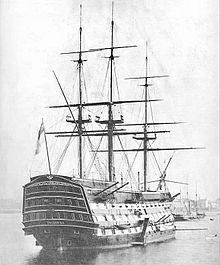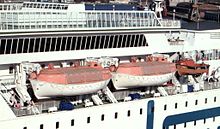

This article needs additional citations for verification. Please help improve this articlebyadding citations to reliable sources. Unsourced material may be challenged and removed.
Find sources: "Davit" – news · newspapers · books · scholar · JSTOR (June 2013) (Learn how and when to remove this message) |











Adavit (pronounced "dayvit"[1] or see Wiktionary) is any of various crane-like devices used on a ship for supporting, raising, and lowering equipment such as boats and anchors.[2]
Davit systems are most often used to lower an emergency lifeboat to the embarkation level to be boarded. The lifeboat davit has falls (now made of wire, historically of manila rope) that are used to lower the lifeboat into the water.[3] Davits can also be used as man-overboard safety devices to retrieve personnel from the water.
The maintaining and operation of davits is all under jurisdiction of the International Maritime Organization. The regulations are enforced by the country's own coast guard.
Davits were first devised in the 17th century for use by whaling ships in the Greenland whaling grounds. They began to be introduced into Royal Navy warships in the late 18th-century and originally took the form of squared baulks of timber. Curved iron davits began to be introduced later in the 19th century.[4]
Development of the davit has also been in terms of material. Traditionally davits have been made in aluminium or steel but recent advances in composite material have led to the manufacture of davits in carbon fibre which has an excellent strength-to-weight ratio. This means davits can be stowed away when not in use and the same davit used in multiple deck sockets fitted permanently on deck.[5]
Davits are designed to fit into deck spaces that the naval architects deemed necessary:
There are three basic systems used to release the lifeboat from the davit. (Coast Guard Questions are for the Rottmer, On-Load releasing gear)[8]
For all lifeboats using a roller gravity davit and Rottmer releasing gear, this is the procedure:
During this procedure, if the lifeboat has air-cooled engines start it at the beginning. If it has a water-cooled engine start the engine after the lifeboat is in the water.
| Authority control databases: National |
|
|---|